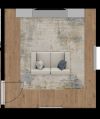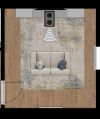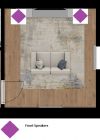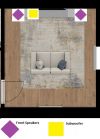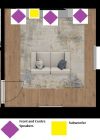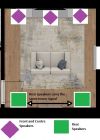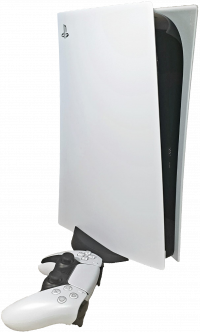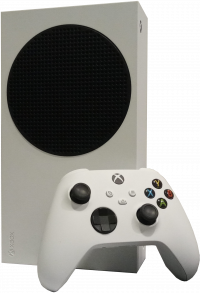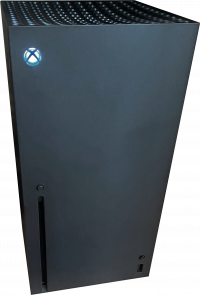Comparison of Game Consoles by Sound Capabilities: Difference between revisions
| Line 765: | Line 765: | ||
* [https://consolemods.org/wiki/File:Stereo%20layout.jpg 2.0] | * [https://consolemods.org/wiki/File:Stereo%20layout.jpg 2.0] | ||
|align="left"| Stereo audio is available from the expansion port but it must be amplified. There were several titles on the PC-Engine that used RSS, including Dracula X and Ys IV. ([https://medium.com/@Karakuroraka/im-not-sure-how-much-further-you-ve-dived-into-the-subject-but-i-m-aware-of-at-least-two-titles-a54fa45ece50 Link]) | |align="left"| Stereo audio is available from the expansion port but it must be amplified. There were several titles on the PC-Engine that used RSS, including Dracula X and Ys IV. ([https://medium.com/@Karakuroraka/im-not-sure-how-much-further-you-ve-dived-into-the-subject-but-i-m-aware-of-at-least-two-titles-a54fa45ece50 Link]) | ||
|- | |||
| [[TG16:TurboGrafx-16 Mods Wiki|NEC PC Engine CD]] | |||
|align="right"| [[File:PCEngineCDROM.jpg|200px]] | |||
|align="left"| 1988 | |||
|align="left"| OKI M5205 (ADPCM) <br> Red Book CD audio | |||
|align="left"| | |||
* Mono | |||
* Stereo | |||
|align="left"| | |||
* [https://consolemods.org/wiki/File:Mono_layout.jpg 1.0] | |||
* [https://consolemods.org/wiki/File:Stereo%20layout.jpg 2.0] | |||
|align="left"| ? | |||
|- | |- | ||
| [[TG16:TurboGrafx-16 Mods Wiki|NEC TurboGrafx 16]] | | [[TG16:TurboGrafx-16 Mods Wiki|NEC TurboGrafx 16]] | ||
Revision as of 11:12, 16 May 2023
When it comes to retro gaming, many enthusiasts tend to focus on graphics and gameplay, but sound can be just as important in creating an immersive experience. From the humble beep of the first video game console to the modern-day surround sound systems, sound capabilities have come a long way in video game consoles. This article aims to provide an overview of the various sound formats and standards used in video game consoles, from mono to stereo and beyond, as well as to offer tips and recommendations for getting the best sound performance out of each console. By comparing the sound capabilities of different consoles, players can make informed decisions on how to optimize their gaming experience.
| DRAFT (WORK IN PROGRESS ARTICLE - PLEASE DO NOT RELY ON THE INFORMATION BELOW UNTIL MARKED AS COMPLETED) |
Explanation of "Channels"
If you’re putting together a console setup for audio, there are some numbers that you’ll notice like 2.1, 5.1, 7.2.2 and so on. These numbers represent "channels", with each channel normally - but not always - corresponding to one physical speaker. (For example, there are plenty of exceptions such as soundbars and surround-sound headsets, so "channels" and "speakers" are not synonymous. While 2.1 might seem to indicate three separate speakers, this may not always be the case).
- The first number (for example, the "5" in a 5.1 setup) defines how many primary channels there are in a setup, at ear level. Usually (but again, not always) this number also refers to the number of regular speakers in the setup. So for example, a standard 5.1 system will normally use five speakers: Front Left, Centre, Front Right, Surround Left and Surround Right. Each channel can receive a separate audio signal. So if the user is playing a game that has its audio mixed in 5.1 surround, the dialogue will probably be sent to the centre speaker, with the other speakers playing audio relative to the action on the screen. This will hopefully add greater immersion and give a more convincing experience.
- The second number stands for the number of LFE (Low Frequency Effects) channels in a setup, which are commonly reproduced by subwoofer speakers. The woofers on regular speakers are not usually powerful enough to effectively reproduce very low-frequency bass sounds. So having the second number displayed separately (for example, the "1" in a 5.1 setup) indicates that this is not a normal speaker. For extra bass, some systems might even support x.2 or even x.4 speaker configurations.
- The third number (for example, the last "2" in a modern 7.2.2 home theatre setup) is a relatively new innovation, and defines how many overhead or height channels there are, which are normally reproduced by ceiling-mounted or in-ceiling speakers. If your system has a third number, this indicates that it supports object-based surround sound formats such as Dolby Atmos or DTS:X, where sounds are recorded as individual objects in 3D space instead of traditional channels. However, it's not strictly necessary for an object-based setup to have actual ceiling speakers. Some standard speakers (or soundbars) have built-in upward-firing speakers that bounce audio off the ceiling, to simulate the effect that the audio is actually coming from above you.
Analog multichannel sound can be implemented as:
- a discrete system, where each channel is delivered independently; (for example, a 5.1 system with 5 or 6 RCA connectors is, at least at that point in the chain, a discrete system)
or
- a matrixed system, where algorithms are used to put multiple channels worth of sound into a lesser amount of physical channels (such as the two stereo RCA cables that were already commonly in use with most audio equipment from the 1970s through to the 1990s)
In digital audio, these terms are less commonly used, but comparable approaches are used depending on circumstances.
Disclaimer
This article is written with the intention of providing practical advice and tips to the average retro gamer who wishes to improve their console audio experience. While accuracy and up-to-date information are essential, the article is not meant to be excessively technical or comprehensive.
For example, in the context of video game consoles, the term "mono" typically refers to the console's output being a single, mixed audio channel, as opposed to true monophonic sound. For instance, the original Nintendo Entertainment System (NES) is sometimes referred to as a "mono" console, despite featuring two pulse wave channels, one triangle wave channel, one noise channel, and a delta modulation channel. Similarly, the ColecoVision used a SN76489 sound chip, which offered four channels, including three tone channels for music and a noise channel.
While channels can be utilized in combination to create complex sounds and music, the output is merged into a single channel. Describing these consoles as anything other than "mono" might confuse the average user, who might assume that adding additional speakers would enhance their audio setup. Therefore, unless a console can output audio in stereo, it will be regarded as a "mono" console.
| Sound System | Year Introduced to Home Market | Explanation | Use in Retro-Gaming context | |
|---|---|---|---|---|

|
Mono | 1899 | “Monaural sound” is simply a single audio channel. A mono signal can be sent from the source device to one, two or many speakers, and all the speakers will play the same sound regardless. While stereo signals can create the impression of hearing sounds from different locations/directions, mono cannot. | Prior to the Turbo-Grafx16, all home video game consoles [1] either sent a mono audio signal to the television, or (in the 1st gen) utilised beepers and built-in speakers to produce simple action sounds. In some instances, stereo mods for these older consoles are available. (e.g. Atari 2600) [2]
In some modern consoles, the ability to enable mono audio (i.e. combining all audio channels into one) can be enabled as an accessibility option for players with single-sided deafness. [3] |

|
Stereo | 1958 | While mono signals are recorded and played back using a single audio channel, stereo sounds are recorded and played back using two discrete audio channels.
Stereo speaker setups are usually laid out in either a 2.0 (no subwoofer) or a 2.1 (with subwoofer) configuration - with a front left speaker and a front right speaker. |
Since its introduction with the Turbo-Grafx 16 [4], Stereo is still the way that the majority of gamers experience sound in video games, although soundbars and surround sound headphones are projected to continue growing in popularity. |

|
Quadrophonic Sound | 1971 | This format had brief popularity in the 1970s, using two front and two rear speakers (all discrete channels). Most quadrophonic musical recordings were extracted from the original stereo mix, although some were mastered in four channels. | Early Playstation 3 units (CECHA/B/C/E) are capable of reading Super Audio CDs (SACDs) which support Quadraphonic sound [5]. Regular SACD players with multichannel analogue outputs have been confirmed to be compatible with 1970s quadrophonic receivers, [6], although whether the PS3 supports this method of output has not been confirmed.
No confirmed use of quadrophonic sound in the audio mixes of any actual video games. By the time game consoles were beginning to move away from use of piezo beepers and built-in speakers, in favour of actually sending audio to the television for output (e.g. the Atari 2600 in 1977), quadrophonic sound had already faded from the mainstream. |
| Dolby Stereo | 1975 | Dolby Stereo was developed in the 1970s for cinema sound systems, and was later adapted for the home as "Dolby Surround". [7] | N/A - See Dolby Surround. | |

|
Binaural Audio | 1978 | Binaural sound is a technique that involves recording audio (usually using two microphones) in such a way that when the user listens to it back, it produces a 3D effect from the stereo signal. The effect arguably works best when listened to using a pair of noise-cancelling headphones.
Although binaural recording techniques have existed since the 1800s, it wasn't until 1978 that Lou Reed released the first commercially produced binaural pop record, "Street Hassle". [8] |
When done correctly, the effect works very well with headphones and VR-based systems (such as Playstation VR).
The technique has also been used in certain games for the PSP and 3DS - for example, the dialogue in Corpse Party and Book of Shadows were both recorded using binaural recording. [9] |

|
LPCM (Linear Pulse Code Modulation) | 1982 | Not a brand of sound format - LPCM refers to raw, uncompressed sound data. LPCM can support any number of potential audio channels, from mono upwards.
LPCM's first home implementation was the lossless encoding of sound data in Audio CDs. [10] |
The PlayStation 3 was first console to offer real-time 7.1 LPCM as an option for sound. Any modern AVR or pre-amp should be able to process these signals, but LPCM cannot be used for object-based sound. [11] |
| Dolby Surround | 1982 | Dolby Surround (i.e. "matrixed surround") was the first multi-channel surround decoding technology to be widely available for use with analogue movie formats and to a lesser extent, home video game consoles.
The format produces four audio channels (Left Front, Right Front, Centre and a single rear surround channel), but they're not discrete. The channels are extracted using a specially encoded signal that runs across the existing two stereo (red and white) RCA cables that were in use with a lot of customer audio equipment of this era. |
In short, the user gets a centre, a front left and right and mono rear.
To access 4.0 surround (i.e., four channels), the user would need an AV amplifier capable of decoding and separating the regular stereo outputs to produce the pseudo-surround sound effect. Discrete left and right sounds still go to the Front Left and Front Right speakers, as per normal Stereo. However, the processor uses one of the front channels to carry a mono rear channel on its inverted phase - there maybe be two or more Rear surround speakers, the mono sound is played equally between them all at the same time. The other front channel is used to carry a centre channel on its inverted phase. If the user’s amplifier could send audio signals below a certain frequency to a subwoofer (using a low-pass filter), the user also could access 4.1 surround. A setup like this would also be backwards-compatible with older formats – if the user had a regular 2.0 stereo setup, the Left and Right signals would play as normal, and if the console was plugged into an older CRT with a mono speaker, all the audio would be routed into that single channel. | |
| THX | 1983 | THX is not its own sound format, but rather a rigid set of standards, originally intended to ensure that the theatrical experience of a movie was as close as possible to the director's intentions.
In the realm of home consumer hardware and VHS/DVDs/video games, THX certification signified that the mastering and duplication process was inspected by THX technicians and held to certain standards. |
Approximately 40 games were THX certified, mainly on the PlayStation 2, original XBox, Gamecube, PlayStation 3 and PC. [12] | |
| Dolby Pro Logic 1 | 1987 | While Dolby Surround added a mono surround channel to the usual front left and front right - this was improved with Dolby Pro Logic 1, which added a centre channel, and used a more advanced algorithm to extract the extra channels, as well as improving the movement and discreteness between them. | Note: *** Did Dolby Surround or Dolby Pro Logic 1 introduce the centre channel? TBC *** Also TBC - did any consoles explicitly support Pro Logic 1, or for our purposes, does Dolby Surround = Dolby Pro Logic 1? | |
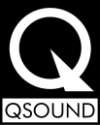
|
QSound | 1991 | QSound is a format that provides greater separation between sound sources in a stereo mix, producing a kind of "fake" surround sound effect using only two speakers. The effect is built into the recording not the decoding, so all that is needed to access QSound is a stereo-capable receiver with two outputs. [13] | According to Andrew Elmore (medium.com)[14] , QSound is utilised on several PlayStation games and is the only 3D audio option employed on the Sega Mega CD, Saturn, and Dreamcast. QSound is a boon to Sega gamers as less than 20 games are confirmed to have used actual multi-channel Dolby Surround sound. [15] |

|
Roland Surround Space | 1991 | A 3D "sound space" technology created by Roland Corporation (similar to QSound), which attempts to create a "3D sound" using two regular speakers in a stereo configuration.
It does not use speakers which "surround" the user, but attempts to direct sound around the room to give the illusion of depth. |
RSS was used in some video games of the early 1990s, but was less successful than competitors such as QSound or Dolby Surround (which were themselves a relative niche market) From a Sega perspective, it was supported by a couple of Mega CD games and less than a dozen Mega LD games. [16] |
| Dolby Digital (originally Dolby Stereo Digital) | 1992 | As technology progressed, it became easier to record multi-channel sound natively. Dolby Digital featured 6 discrete channels of audio in the ubiquitous 5.1 setup (5 speakers, 1 subwoofer). | The first video game console to use 5.1 Dolby Digital encoding was the original Xbox, which was released by Microsoft in 2001. The Xbox was the first console to feature an optical digital audio output, which allowed for high-quality digital audio output, including support for Dolby Digital 5.1 surround sound. Many Xbox games took advantage of this capability, offering immersive and detailed sound design that helped to enhance the gaming experience. [17] | |
| DTS Digital Surround | 1993 | The original DTS system was a CD-based digital sound format that synced the compressed audio on a CD with whatever video frame was on-screen at a given time.
The theatrical version did not feature a discrete subwoofer, with a low-pass filter being applied to the surround channels instead and the subwoofer extracted from them. The home version however offered true 5.1 channel audio, with a discrete subwoofer. |
Sony's PlayStation 3 and Microsoft's Xbox 360 are capable of DTS decoding and output via TOSLINK or HDMI as LPCM. However, HDMI output on the Xbox 360 is only found on the "Elite" model and newer models available since mid-2007, with the release of the Falcon motherboard revision. Also, the Xbox 360 cannot decode DTS from DTS audio CDs.
PlayStation 3 consoles can bitstream DTS over HDMI, but cannot decode audio from DTS audio CDs. The newer "slim" models are able to bitstream DTS-HD MA as well, but also cannot decode audio from DTS CDs. (Link) (Note: need to confirm that the version of DTS applied on the PS3 is same as Jurassic Park in 1993). | |
| DTS: ES | 1999 | DTS: ES came out at the same time as Dolby Surround EX in the theatres and processed the centre surround in the same way (Note: expand on this) | Confirmed supported on PS3 and XBox 360 (expand on this) | |
| Dolby Pro Logic 2 | 2000 | Similar to Pro Logic 1 but with the addition of stereo surround channels. Better processing is taking place that tells the surround channels how to steer the sound around the user. | Pro Logic II systems also feature a mode designed specifically for video gaming, and was frequently used in game titles for Sony's PlayStation 2, Nintendo's GameCube and Wii as an alternative to digital surround formats such as Dolby Digital, or DTS. Game mode is similar to Movie mode, except it redirects more bass to the LFE channel. (link) | |

|
DTS Neo:6 | 2000 | From an analog perspective, DTS Neo-6 replicated what Dolby Pro Logic 2 accomplished from a stereo connection (expand) | TBC - Neo:6 may not require a given console to explicitly "support" it, as this is a post-processing format. https://www.quora.com/What-is-DTS-Neo-6 |
| Dolby Pro Logic IIx | 2003 | Can take two-channel stereo, Dolby Surround, and Dolby Digital 5.1 source material and then upscale it to 6.1 or 7.1 channel surround sound. | TBC - is this another post-processing format? Couldn't find any consoles incorporating Dolby Pro Logic IIx signal processing. | |

|
DTS-HD High Definition Audio | 2004 | This was DTS's equivalent of Dolby Digital Plus. | Confirmed supported by PS3 (expand!) |

|
DTS Interactive | 2005 | DTS (DTS Interactive) had a four-channel format for the home that used Left, Right, Left Surround, and Right Surround speakers. | This was the only discrete format (beyond Stereo) that the PS2 could process in real time, and a few games used this. |
| Dolby TrueHD | 2006 | Continued improvement to the number of channels as well as maximum bit-rate and sample-rate. (confirm!) Unlike most audio formats, Dolby TrueHD is 100 percent lossless. This means that what you hear is bit-for-bit identical to the master recording. | Confirmed to be supported by PS3 (more details TBC) | |
| DTS-HD Master Audio | 2007 | This was DTS' equivalent to Dolby's TrueHD, and was also a lossless format. | Confirmed to be supported by PS3 (more details TBC) | |
| Dolby Pro Logic IIz | 2009 | Expands on Pro Logic IIx with the addition of a height component, creating front height channels above the front left and right speakers, expanding a 5.1 or 7.1 system to 7.1 Height or 9.1. It identifies spatial cues in low-level, uncorrelated information, such as ambience and effects like rain or wind in the side and rear surround channels, and directs it to the front height speakers. The channels it adds are matrixed, not discrete. (link) | ? | |
| DTS Neo:X | 2009 | Replicates what Dolby Pro Logic 2z accomplished from a stereo connection (expand!) | TBC | |
| Dolby Atmos | 2014 | Dolby Atmos supports up to 128 audio objects (i.e. sounds) that are independent of a channel assignment. Sounds can be created independently and mapped to an exact specific location. The user can hear a spatially-accurate sound effect, no matter where they are sitting in the room. Dolby Atmos can use up to 24 independent speaker locations plus a subwoofer, and typically uses overhead speakers. | The first console to have Dolby Atmos enabled (via a downloadable app) was the XBox One (more detail TBC) | |
| DTS:X | 2015 | DTS:X is DTS’s take on Dolby Atmos and uses object-based sounds and height channels in the same fashion as Dolby Atmos. | Confirmed supported by XBox One (expand!) |
Speaker Layouts
First generation of consoles
| Console | Pictures | Year of Release | Audio Hardware | Supported Audio Formats | Supported Speaker Layouts | Notes |
|---|---|---|---|---|---|---|
| Magnavox Odyssey | 
|
1972 | None | N/A | N/A | The console cannot generate audio. |
| Magnavox Odyssey 100 | 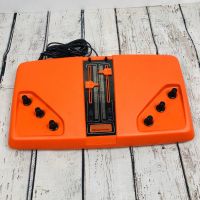
|
1975 | Piezzo beeper (Built-in speaker) | Mono | 1.0 | The console didn't send audio to the tv, instead using an internal piezzo beeper which emitted primitive action sounds through a built-in speaker - for example, a "blip" when the tennis ball is hit by a player's paddle, or when the hockey puck hits the borders of the playing area. |
| Magnavox Odyssey 200 | 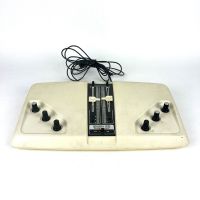
|
1975 | Piezzo beeper (Built-in speaker) | Mono | 1.0 | The console's piezo beeper operated in the same manner as the Odyssey 100. The Odyssey 200 added an extra game called SMASH (i.e. squash); the buzzer would bleep whenever the ball hit the front "wall". |
| Magnavox Odyssey 300 | 
|
1976 | G.I. AY-3-8500 chip (Built-in speaker) | Mono | 1.0 | As before, during play, a different audio tone (little more than a few bleeps and bloops) is generated each time the ball hits a player, a wall, or a point is scored. No provisions are made to turn the sound on or off, which emanates from a speaker in the Odyssey console itself. |
| Magnavox Odyssey 400 | 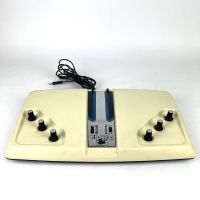
|
1976 | ? | Mono | 1.0 | ? |
| Magnavox Odyssey 500 | 
|
1976 | ? | Mono | 1.0 | ? |
| Magnavox Odyssey 4305 | 
|
1976/1977 | ? | Mono | 1.0 | The Odyssey 4305 is a 19” television (based on the chassis of the Magnavox T991 television) but with a built-in Odyssey. As with most CRTs of this era, the sound was an analog signal produced from small speakers installed inside the chassis. It produced sound in mono and action sounds were similar to other Odyssey series consoles. |
| Magnavox Odyssey 2000 | 
|
1977 | ? | Mono | 1.0 | ? |
| Magnavox Odyssey 3000 | 
|
1977 | ? | Mono | 1.0 | ? |
| Magnavox Odyssey 4000 | 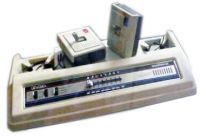
|
1977 | ? | Mono | 1.0 | ? |
| Philips Odyssey 200 | 
|
1976 (released concurrently with U.S. Odyssey 200) | ? | Mono | 1.0 | ? |
| Philips Odyssey 2001 | 
|
1977 | ? | Mono | 1.0 | ? |
| Philips Odyssey 2100 | 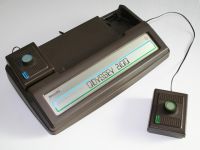
|
1978 | ? | Mono | 1.0 | ? |
| TV Tennis Electrotennis (Epoch) | 
|
1975 | ? | Mono | 1.0 | ? |
| Atari Home Pong (Model C-100) | 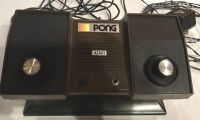
|
1976 | ? | Mono | 1.0 | ? |
| Atari Super Pong (Model C-140) | 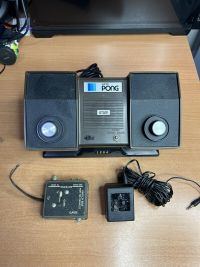
|
1976 | ? | Mono | 1.0 | The console had a speaker built into the main unit, that could output a simple "bloop" noise every time the ball was hit. |
| Coleco Telstar | 
|
1976 | ? | Mono | 1.0 | ? |
| Coleco Telstar Classic | 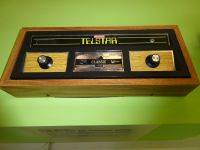
|
1976 | ? | Mono. | 1.0 | ? |
| Coleco Telstar Deluxe (AKA World of Sports) | 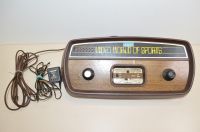
|
1977 | ? | Mono | 1.0 | ? |
| Coleco Telstar Ranger | 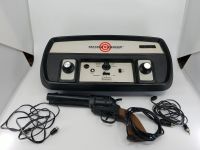
|
1977 | ? | Mono | 1.0 | ? |
| Coleco Telstar Alpha | 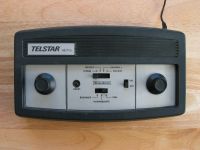
|
1977 | ? | Mono | 1.0 | ? |
| Coleco Telstar Colormatic | 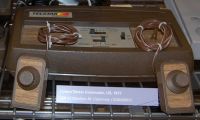
|
1977 | ? | Mono | 1.0 | ? |
| Coleco Telstar Regent | 
|
1977 | ? | Mono | 1.0 | ? |
| Coleco Telstar Sportsman | TBC | 1978 | ? | Mono | 1.0 | ? |
| Coleco Telstar Combat! | 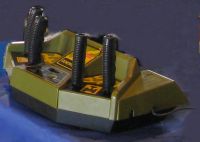
|
1977 | ? | Mono | 1.0 | ? |
| Coleco Telstar Colortron | 
|
1978 | ? | Mono | 1.0 | ? |
| Coleco Telstar Marksman | 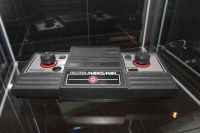
|
1978 | ? | Mono | 1.0 | ? |
| Coleco Telstar Galaxy | 
|
1977 | ? | Mono | 1.0 | ? |
| Coleco Telstar Gemini | 
|
1977 | ? | Mono | 1.0 | ? |
| Coleco Telstar Arcade | 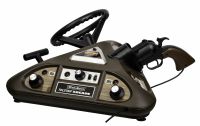
|
1977 | ? | Mono | 1.0 | ? |
| Nintendo Color TV - Game 6 | 
|
1977 | ? | Mono | 1.0 | ? |
Second generation of consoles
| Console | Pictures | Year of Release | Audio Hardware | Supported Audio Formats | Supported Speaker Layouts | Notes |
|---|---|---|---|---|---|---|
| Atari 2600 | 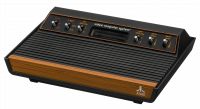
|
1977 | Atari TIA |
Mono (Stock) Stereo (Modded) |
1.0 | "Stereo" mods exist which split the TIA's two audio channels into left and right audio |
| Magnavox Odyssey 2 | 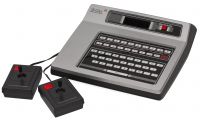
|
1978 | Intel 8244 | Mono | 1.0 | ? |
| Philips Videopac G7000 (European release of Odyssey 2) | 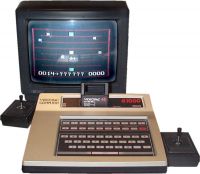
|
1978 | Intel 8245 | Mono | 1.0 | ? |
| Mattel Intellivision | 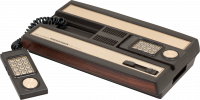
|
1979 | General Instruments AY-3-8914 | Mono | 1.0 | ? |
| Mattel Intellivision II | 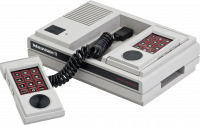
|
1983 | General Instruments AY-3-8914 | Mono | 1.0 | ? |
| Coleco ColecoVision | 
|
1982 | Texas Instruments SN76489AN |
Mono (Stock) Stereo (Modded) |
1.0 | ? |
| Atari 5200 (Four controller port model) * | 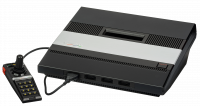
|
1982 | Atari POKEY | Mono | 1.0 | ? |
| Atari 5200 (Two controller port model) * | 
|
1983 | Atari POKEY | Mono | 1.0 | ? |
| GCE/MB Vectrex | 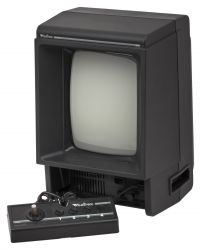
|
1982 | General Instruments AY-3-8912 |
Mono (Stock) Stereo (Modded) |
1.0 (Stock) 2.0 (Modded) |
Vectrex uses a General Instruments AY-3-8912 sound chip to deliver surprisingly good music and sound effects, as well as limited voice synthesis, via a 3-inch built-in paper cone speaker. A mod is available to add compatibility with external stereo speakers.
|
Third generation of consoles
| Console | Pictures | Year of Release | Audio Hardware | Supported Audio Formats | Supported Speaker Layouts | Notes |
|---|---|---|---|---|---|---|
| Nintendo Entertainment System (US) | 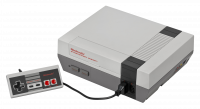
|
1985 | Ricoh 2A03 | Mono | 1.0 | "Stereo" mods exist, but these simply divide some of the 2A03's audio channels between left and right. |
| Nintendo Entertainment System (PAL) | 
|
1986 | Ricoh 2A07 | Mono | 1.0 | "Stereo" mods exist, but these simply divide some of the 2A03's audio channels between left and right. |
| Famicom | 
|
1983 | Ricoh 2A03 | Mono | 1.0 | "Stereo" mods exist, but these simply divide some of the 2A03's audio channels between left and right. |
| Famicom Disk System | 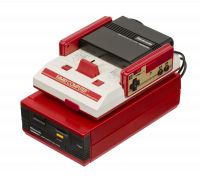
|
1986 | Ricoh 2C33 | Mono | 1.0 | The Famicom Disk System generates an extra wavetable audio channel which is mixed in with the Famicom's internal audio |
| Twin Famicom | 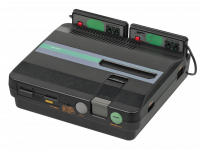
|
1986 | Ricoh 2A03 + Ricoh 2C33 | Mono | 1.0 | ? |
| Sega SG-1000 | 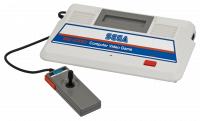
|
1983 | Texas Instruments SN76489AN | Mono | 1.0 | ? |
| Sega SG-1000 II | 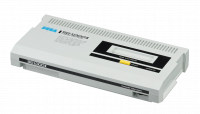
|
1984 | Texas Instruments SN76489AN (early revision) Sega 315-5066 (later revision) |
Mono | 1.0 | ? |
| Sega Mark III | 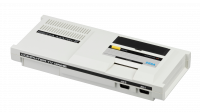
|
1985 | Sega 315-5124 | Mono | 1.0 | ? |
| Sega Master System | 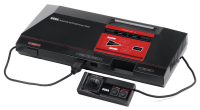
|
1986 | Sega 315-5124 | Mono | 1.0 | ? |
| Atari 7800 | 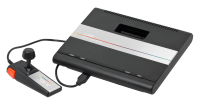
|
1986 | Atari TIA | Mono | 1.0 | "Stereo" mods exist which split the TIA's two audio channels between left and right audio |
| Casio PV-1000 | 
|
1983 | NEC D65010G031 | Mono | 1.0 | ? |
| Epoch Super Cassette Vision | 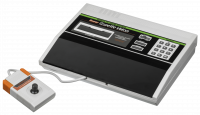
|
1984 | NEC D1771C | Mono | 1.0 | ? |
| Amstrad GX4000 | 
|
1990 | Microchip Technology AY-3-8912 | Mono | 1.0 | ? |
Fourth generation of consoles
| Console | Pictures | Year of Release | Audio Hardware | Supported Audio Formats | Supported Speaker Layouts | Notes |
|---|---|---|---|---|---|---|
| PC Engine | 
|
1987 | Hudson HuC6280 |
|
Stereo audio is available from the expansion port but it must be amplified. There were several titles on the PC-Engine that used RSS, including Dracula X and Ys IV. (Link) | |
| NEC PC Engine CD | 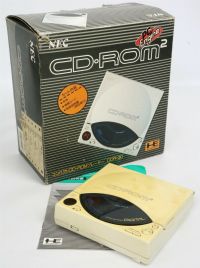
|
1988 | OKI M5205 (ADPCM) Red Book CD audio |
|
? | |
| NEC TurboGrafx 16 | 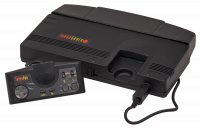
|
1989 | Hudson HuC6280 |
|
Although it shipped with only an RF port, the TurboGrafx-16 is notable as the first home gaming console to offer stereo audio (the Japanese version - the PC Engine - having been released in 1987). The console featured an expansion port that allowed for stereo audio with amplification and composite video output; to achieve this, the user needed to purchase an add-on such as the TurboBooster.
Unlike earlier consoles (from the Atari 2600 to the NES), which subsequently received homebrew hardware modifications to allow stereo audio, the TurboGrafx-16/PC Engine had games which were intentionally programmed with different audio channels, allowing for stereo audio effects where specific sounds or music elements emanated from either the right of the left speaker. This enhanced the overall audio experience for gamers. | |
| PC Engine | 
|
1987 | Hudson HuC6280 |
|
Stereo audio is available from the expansion port but it must be amplified. There were several titles on the PC-Engine that used RSS, including Dracula X and Ys IV. (Link) | |
| NEC PC Engine CD | 
|
1988 | OKI M5205 (ADPCM) Red Book CD audio |
|
? | |
| NEC TurboGrafx-CD * | 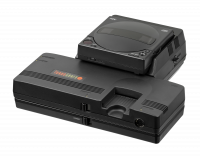
|
1989 | OKI M5205 (ADPCM) Red Book CD audio |
|
? | |
| NEC SuperGrafx | 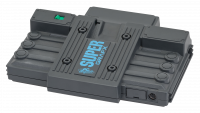
|
1989 | Hudson HuC6280 |
|
? | |
| NEC TurboExpress/PC Engine GT | 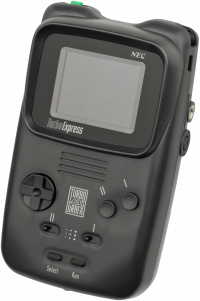
|
1990 | Hudson HuC6280 |
|
The system only has a single speaker but stereo out is available from the headphone jack | |
| NEC TurboDuo/PC Engine Duo | 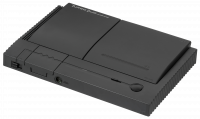
|
1991 | Hudson HuC6280 Oki M5205 (ADPCM) Red Book CD audio |
|
? | |
| NEC Super CD-ROM2 | 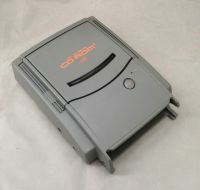
|
1991 | Oki M5205 (ADPCM) Red Book CD audio |
|
? | |
| NEC PC Engine LT | 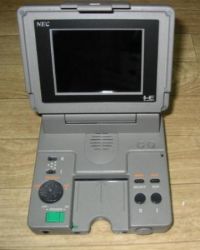
|
1991 | Hudson HuC6280 |
|
The system only has a single speaker but stereo out is available from the headphone jack | |
| NEC PC Engine Duo-R/Duo-RX | 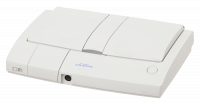
|
1993 | Hudson HuC6280 Oki M5205 (ADPCM) Red Book CD audio |
|
? | |
| Sega Genesis (model 1) | 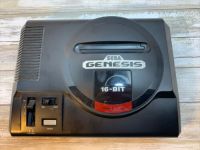
|
1989 | Yamaha YM2612 (FM + PCM) Sega VDP (PSG) |
|
The AV connector only has mono out but stereo out is available from the headphone jack | |
| Sega Mega Drive (model 1) | 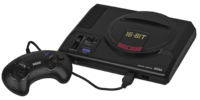
|
1988 | Yamaha YM2612 (FM + PCM) Sega VDP (PSG) |
|
The AV connector only has mono out but stereo out is available from the headphone jack | |
| Sega Genesis (model 2) | 
|
1994 | Yamaha YM3438 core (FM + PCM) Sega VDP (PSG) |
|
? | |
| Sega Genesis 3 | 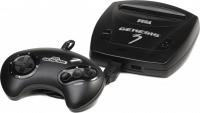
|
1998 | Yamaha YM3438 core (FM + PCM) Sega VDP (PSG) |
|
|
Can be modified for stereo sound |
| Sega Mega Jet | 
|
1994 | Yamaha YM3438 core (FM + PCM) Sega VDP (PSG) |
|
? | |
| Sega Nomad | 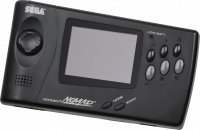
|
1995 | Yamaha YM3438 core (FM + PCM) Sega VDP (PSG) |
|
The system only has a single speaker but stereo out is available from the headphone jack and AV out | |
| Sega CD | 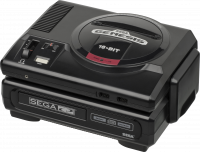
|
1991 | Ricoh RF5C164 |
|
'Snatcher' and 'Shadow of the Beast 2' confirmed to support RSS. (Link) | |
| Sega 32X | 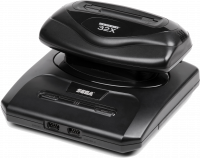
|
1994 | Sega 315-5818 |
|
? | |
| Sega/Victor Wondermega RG-M1 | 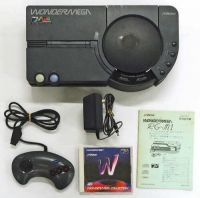
|
1992 | ? |
|
? | |
| Sega CDX | 
|
1994 | ? |
|
? | |
| JVC X'Eye/Victor Wondermega RG-M2 | 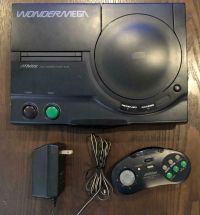
|
1993 | ? |
|
? | |
| Sega Game Gear * | 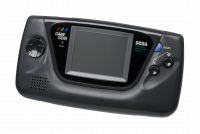
|
1990 | ? |
|
The system only has a single speaker but stereo out is available from the headphone jack | |
| Nintendo Game Boy | 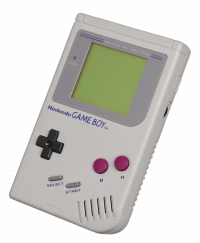
|
1989 | Sharp LR35902 |
|
The system only has a single speaker but stereo out is available from the headphone jack | |
| Nintendo Game Boy Pocket | 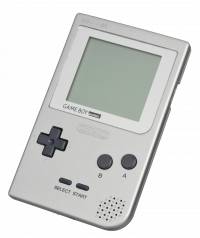
|
1996 | CPU MGB |
|
The system only has a single speaker but stereo out is available from the headphone jack | |
| Super Nintendo (US) | 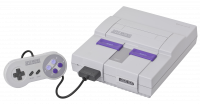
|
1991 | ? |
|
||
| Super Famicom * | 
|
1990 | ? |
|
? | |
| Super Nintendo (PAL) * | 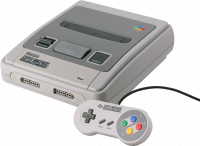
|
1992 | ? |
|
? | |
| SNK Neo Geo AES * | 
|
1990 | Yamaha YM2610 |
|
The AV connector only has mono out but stereo out is available from the headphone jack | |
| SNK Neo Geo CD | 
|
1994 | Yamaha YM2610 + Red Book CD audio |
|
? | |
| Pioneer LaserActive | 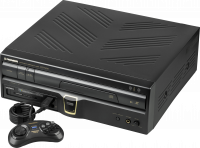
|
1993 | ? |
|
? |
Fifth generation of consoles
| Console | Pictures | Year of Release | Audio Hardware | Supported Audio Formats | Supported Speaker Layouts | Notes |
|---|---|---|---|---|---|---|
| Commodore Amiga CD32 | 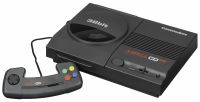
|
1993 | Commodore Paula Red Book CD audio |
|
| |
| Panasonic 3DO | 
|
1993 | ? |
|
| |
| Atari Jaguar * | 
|
1993 | Motorola SC414201FT/Atari Jerry |
|
| |
| Atari Jaguar CD * | 
|
1995 | Red Book CD audio | ? | ? | ? |
| Bandai Playdia * | 
|
1994 | Asahi Kasei AK8000 Red Book CD audio |
|
The console has a standard red/white right/left audio output socket and yellow composite video output (Source: Adam Koralik - Bandai Playdia - Fifth VideoGame Generation Recap) | |
| Sega Saturn | 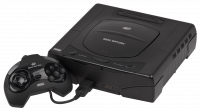
|
1994 | Yamaha YMF292/Sega 315-5687 Red Book CD audio |
|
? | |
| Sony PlayStation | 
|
1994 | Sony SPU Red Book CD audio |
|
? | |
| Sony PSone | 
|
2000 | Sony SPU Red Book CD audio |
? | ? | ? |
| NEC PC-FX | 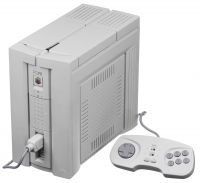
|
1994 | Hudson HuC6230 Red Book CD audio |
|
16-Bit Stereo with 2 ADPCM channels and 6 sample channels at 44.1kHz. | |
| Casio Loopy | 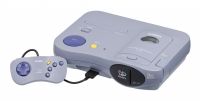
|
1995 | ? |
|
The console has a standard red/white right/left audio output socket and yellow composite video output (Source: Adam Koralik - Casio Loopy - Fifth VideoGame Generation Recap) Mono accessed via Left/white output. | |
| Apple Pippin | 
|
1996 | ? |
|
RCA composite left/right stereo, 16-bit 44 kHz sampled, and headphone output jack | |
| Nintendo 64 | 
|
1996 | Nintendo RCP-NUS |
|
TBC - Dolby surround confirmed with Ocarina of Time and unreleased Dinosaur Planet http://archive.thegia.com/n64/dino/dino.html |
Sixth generation of consoles
| Console | Pictures | Year of Release | Audio Hardware | Supported Audio Formats | Supported Speaker Layouts | Notes |
|---|---|---|---|---|---|---|
| Game Boy Advance | 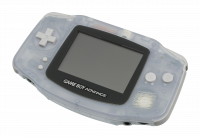
|
2001 | ? |
|
The system only has a mono speaker but stereo out is available from the headphone jack | |
| Game Boy Advance SP | 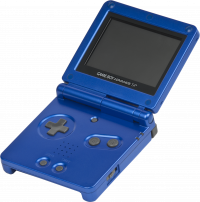
|
2003 | ? |
|
The system only has a mono speaker but stereo out is available from the headphone/charging connector | |
| Game Boy Micro | 
|
2005 | ? |
|
The system only has a mono speaker but stereo out is available from the headphone jack | |
| Sega Dreamcast | 
|
1998 | ? |
|
? | |
| Sony PlayStation 2 (original) | 
|
2000 | ? |
|
The PlayStation 2 was the first game console to output digital audio, in this case via an optical connector.
Four-channel DTS Interactive was the only discrete format (beyond Stereo) that the PS2 could process in real time and this was used by nearly a dozen games, including Grand Theft Auto: Vice City and Terminator 3: Rise of the Machines. The PS2 could also send a 5.1 Dolby Digital stream, but only during cut scenes where the audio didn't have to be dynamically generated on the spot. | |
| Sony PlayStation 2 (slim, SCPH-7xxxx) | 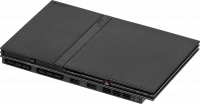
|
2004 | ? |
|
? | |
| Sony PlayStation 2 (slim, SCPH-9000x) | 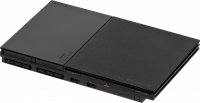
|
2007 | ? |
|
? | |
| VM Labs Nuon | 
|
2000 | ? |
|
32-megabyte 8-bit Fast Page DRAM at 33 MHz, 512-kilobytes sound RAM and 24-kilobytes programmable ROM | |
| Microsoft Xbox | 
|
2001 | ? |
|
Digital output only officially available with certain cables | |
| Nintendo GameCube | 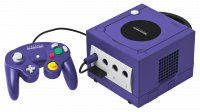 
|
2001 | ? |
|
Panasonic Q version of the Gamecube may have been the first console in history to support the native use of subwoofers, mainly for DVD playback as opposed to in-game use. Digital audio available from digital output (but not officially used). |
Seventh generation of consoles
| Console | Pictures | Year of Release | Audio Hardware | Supported Audio Formats | Supported Speaker Layouts | Notes |
|---|---|---|---|---|---|---|
| Nintendo DS series incl. DSi | 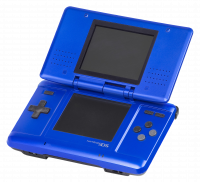
|
2004 | ? |
|
Most titles with sound options have said choices for simulated surround. A few others have a forced mono option instead. | |
| Sony PSP (except N1000/Go) | 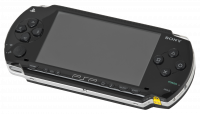
|
2004 | ? |
|
? | Most PSP software only offers plain stereo (except for the XMB's media player, which offers EQ presets available by short pressing the "sound" key only with external phones/speakers). PSP E1000/Street has a single mono speaker. PS1 software keeps original sound capabilities. |
| Sony PSP-N1000 series (Go) | 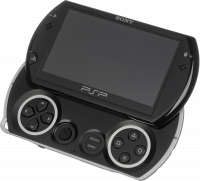
|
2009 | ? | ? | ? | First console to support Bluetooth for general purpose audio output. |
| Nintendo Wii | 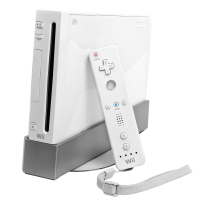
|
2006 | ? |
|
? | |
| Microsoft Xbox 360 series | 
|
2005 | ? |
|
Fat models require a suitable video cable for optical audio, Slims (S) also have Toslink built in, while Superslims (E) don't offer it at all. | |
| Microsoft Xbox 360 E | 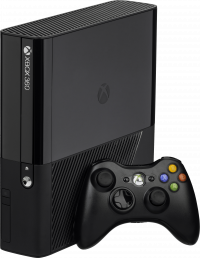
|
2013 | ? |
|
? | |
| Sony PlayStation 3 | 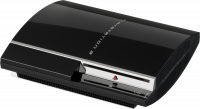
|
2006 | ? |
|
|
Audio output formats
A/V-Multi Analog stereo TOSLINK LPCM 2ch 44.1 kHz, 48 kHz, 88 kHz, 176.4 kHz Dolby Digital 5.1 DTS 5.1 AAC HDMI LPCM 2ch, 5.1ch, 7.1ch 44.1 kHz, 48 kHz, 88 kHz, 96 kHz, 176.4 kHz, 192 kHz DTS-HD Master Audio Bitstream (slim models only)* Dolby TrueHD Bitstream (slim models only)* Dolby Digital 5.1 DTS 5.1 AAC \*All models can decode Dolby TrueHD and as of firmware 2.30 DTS-HD Master Audio, to be output as LPCM. Output of the raw undecoded stream is limited to slim models.[6] |
Eighth generation of consoles
| Console | Pictures | Year of Release | Audio Hardware | Supported Audio Formats | Supported Speaker Layouts | Notes |
|---|---|---|---|---|---|---|
| Nintendo 3DS/2DS Series incl. New | 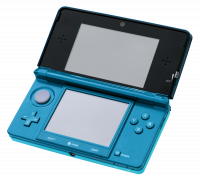
|
2011 | ? |
|
"Surround" is simulated 3D sound. O2DS has mono speaker. | |
| Sony PS Vita | 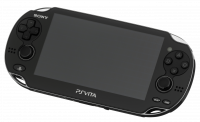
|
2011 | ? |
|
? | ? |
| Sony PS Vita TV | 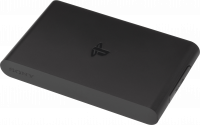
|
2013 | ? |
|
? | ? |
| Nintendo Wii U | 
|
2012 | ? |
|
? | |
| Sony PlayStation 4 (original) | 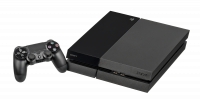
|
2013 | ? |
|
? | |
| Sony PlayStation 4 (slim) | 
|
2016 | ? |
|
The optical audio port was removed on the PS4 slim models. | |
| Sony PlayStation 4 Pro | 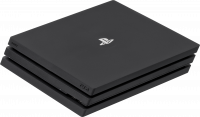
|
2016 | ? |
|
When setting your console up, as you’ll need to change it to set your sound from the standard PCM to bitstreaming Dolby Digital or DTS. The PS4 Pro also only supports Dolby Atmos for compatible Blu-ray movies, it does not support Atmos for games. | |
| Microsoft Xbox One | 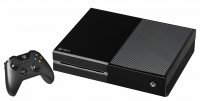
|
2013 | ? |
|
||
| Microsoft Xbox One S | 
|
2016 | ? |
|
||
| Microsoft Xbox One X | 
|
2017 | ? |
|
||
| Nintendo Switch | 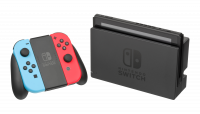
|
2017 | ? |
|
? |
Ninth generation of consoles
External links
- "(Video) RetroRGB - Surround Sound - Music First".
- "(Video) RetroRGB - CRT's + Magnetically Shielded Speakers".
- "(Video) Mythic Resonance - Surround Sound On Retro Video Game Consoles".
- "AV Receiver Surround Sound Formats Comparison (by Gene DellaSala, 2016)".
- "Digital Sound and Music in Video Games".
- ↑ https://forum.digitpress.com/forum/showthread.php?24851-The-first-home-video-game-system-with-stereo-sound-was
- ↑ https://forums.atariage.com/topic/199461-atari-2600-stereo-mod/
- ↑ https://support.xbox.com/en-IE/help/account-profile/accessibility/listen-in-mono#:~:text=On%20an%20Xbox%20console&text=Press%20the%20Xbox%20button%20%EE%8F%A3,and%20then%20select%20Mono%20output.
- ↑ https://forum.digitpress.com/forum/showthread.php?24851-The-first-home-video-game-system-with-stereo-sound-was
- ↑ https://www.youtube.com/watch?v=AcBO3wHwdWE&t=1172s
- ↑ https://www.quadraphonicquad.com/forums/threads/playing-sacds-with-quad-receivers-buying-sacds.27674/
- ↑ https://entertainment.time.com/2013/09/16/how-did-dolby-sound-change-the-movies/
- ↑ https://en.wikipedia.org/wiki/Street_Hassle
- ↑ https://www.reddit.com/r/vita/comments/2spzqk/dont_play_corpse_party_in_the_dark_with_headphones/
- ↑ https://www.loc.gov/preservation/digital/formats/fdd/fdd000011.shtml
- ↑ https://www.ps3blog.net/about/ps3-specs//
- ↑ https://thx.fandom.com/wiki/List_of_THX_Certified_Video_Games
- ↑ https://www.youtube.com/watch?v=vI9UUjrpNVs&t=388s
- ↑ https://medium.com/@AndrewElmore/did-you-know-these-retro-game-consoles-are-capable-of-surround-sound-70336b760252
- ↑ https://segaretro.org/Dolby_Surround#Dreamcast
- ↑ https://segaretro.org/Roland_Sound_Space
- ↑ https://www.techradar.com/news/gaming/consoles/gaming-audio-101-everything-you-need-to-know-about-surround-sound-1292323
